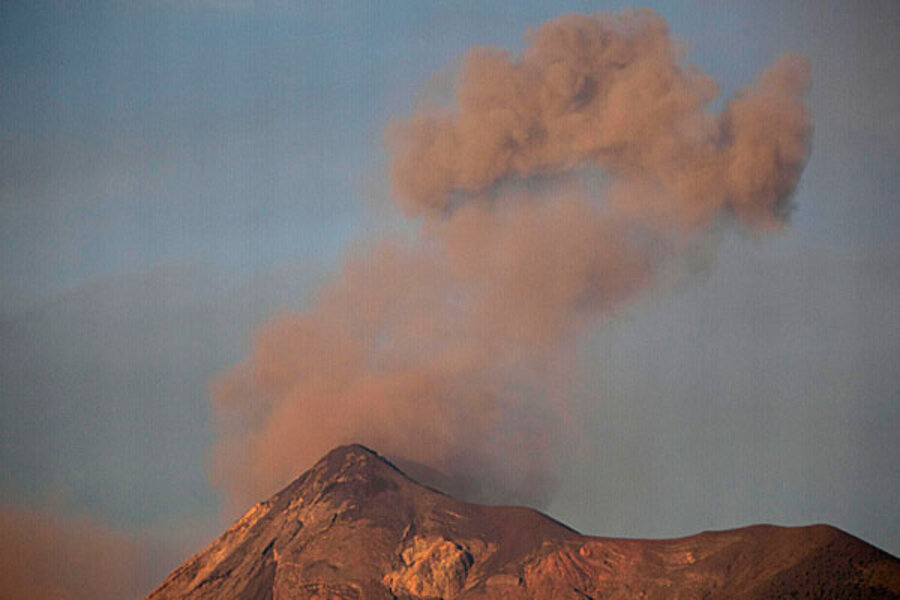Video: Guatemala volcano forces 17 villages to be evacuated
Loading...
| Escuintla, Guatemala
Villagers and farmers living at the foot of a Guatemalan volcano say they were awoken by a massive roar when the long-simmering Volcan del Fuego exploded with a series of eruptions that darkened the skies and covered the surrounding sugar cane fields with ash.
"It thundered and then it got dark as the ash began falling," said Miriam Curumaco, a 28-year-old homemaker from the village of Morelia who was evacuated along with 16 family members to a makeshift shelter at a nearby elementary school. "It sounded like a pressure cooker that wouldn't stop."
As the Volcan del Fuego, or Volcano of Fire, spewed rivers of bright orange lava down its flanks on Thursday, authorities ordered more than 33,000 people in 17 nearby communities evacuated. Many of those near the volcano are indigenous Kakchikeles people who live in relatively poor and isolated communities.
IN PICTURES: Pardon the eruption
Hundreds of cars, trucks and buses, blanketed with charcoal gray ash, drove away from the volcano, which sits about six miles (16 kilometers) southwest of the colonial city of Antigua, toward the Guatemala city. Thick clouds of ash reduced visibility to less than 10 feet in the area of sugar cane fields surrounding the volcano. The elderly, women and children were evacuated in old school buses and ambulances.
But many people refused to leave their homes, said Jose Martinez, who volunteered the bus he uses as a shuttle at the nearby Grupo Pantaleon sugar cane plantation to move people away from the volcano.
"Some people think that this will pass and others think their things won't be there when they go back," Martinez said.
Authorities set up a shelter at an elementary school in Santa Lucia, the town closest to the volcano, and by Thursday night some 750 people had arrived. Most were women and children carrying blankets and going into bare classrooms.
Families mostly made up of small children and toddlers waited patiently as teachers who had volunteered to assist in rescue efforts took their names, deciding which of the 22 rooms filled with top to bottom murals they would be sleeping in. Soldiers unloaded water, orange soda and food from trucks.
Carumaco, who was at the shelter with her family, said parents sent their children to school despite the darkening skies, but that classes were later cancelled and teachers walked them home.
"The kids were home by 10 a.m. They were laughing because they're too young to have seen something like this but they were also coughing and I was very worried," she said.
Guatemala's head of emergency evacuations, Sergio Cabanas, said the ash was blowing south-southeast and authorities said the tourist center of Antigua, with a population of 45,000, was not currently in danger, although they expected the eruption to last into Friday morning.
The emergency agency said lava rolled nearly 2,000 feet (600 meters) down slopes around the 12,346-foot-high (3,763-meter-high) Volcan del Fuego.
"A paroxysm of an eruption is taking place, a great volcanic eruption, with strong explosions and columns of ash," said Gustavo Chicna, a volcanologist with the National Institute of Seismology, Vulcanology, Meteorology and Hydrology. He said cinders spewing from the volcano were settling a half-inch thick in some places.
He said extremely hot gases were also rolling down the sides of the volcano, which was almost entirely wreathed in ash and smoke.
There was a red alert, the highest level, south and southeast of the mountain, where, Chicna said, "it's almost in total darkness."
Guatemala's aviation administration said it had suspended all flights from the southern Mexican city of Tapachula to Guatemala City.
By Thursday evening, the ash plume had decreased to a little more than a mile high, partly due to heavy rain, which diminished the potential risk to aviation, said Jorge Giron, a government volcanologist. He said ash continued to fall heavily, however, and advised residents near the volcano but outside of evacuation zones to clean their water systems before using them, and to not leave their homes because of the ash.
He said a red alert would be in effect until 4 a.m. local time.
Teresa Marroquin, disaster coordinator for the Guatemalan Red Cross, said the organization had set up 10 emergency shelters and was sending hygiene kits and water.
"There are lots of respiratory problems and eye problems," she said.
Officials in the Mexican state of Chiapas, on the border with Guatemala, said they were monitoring the situation in case winds drove ash toward Mexico.
IN PICTURES: Pardon the eruption
_____
Alberto Arce reported from Tegucigalpa, Honduras.
Copyright 2012 The Associated Press.







